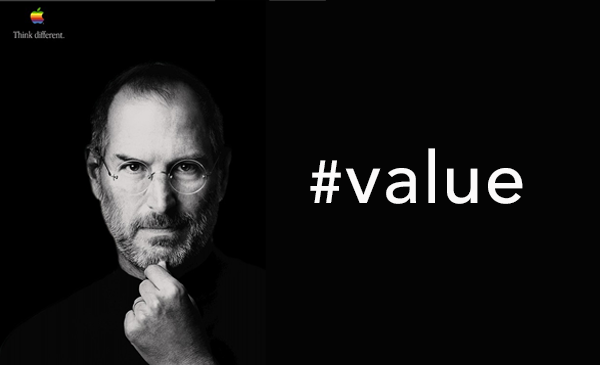Value Marketing changes the conversation away from price.
I recently watched a very interesting video. It was Steve Jobs after he reclaimed his role as the head of Apple. He was doing a presentation to one of his teams in what looked like a dilapidated lecture hall in comparison to the concert setting we’re now accustomed to with Apple product unveils.
During his presentation, he was discussing the launch of the now, legendary campaign, Think Different. During his presentation, he continued to harp on value marketing basics we all try to follow today. Talk less about the features and more about the value of what they bring you.
What is your value?
One of the worst communication traits we all tend to have is that we don’t talk enough about our value, instead of our features/skills.
Our CV/Resumes are bullet points of what skills we know or what we’ve solved before, but rarely do we clearly establish the value. The perceived value is why Apple can charge what they charge.
There’s a process in positioning your value. Steve Jobs for all of his genius didn’t just walk into Think Different. He worked with agencies, and they were grinding and grinding and grinding to simplify the feeling they wanted to establish with their customers.
There’s a simple, not easy process for clarifying your value and it starts with 4 simple levels.
Know: What is it you know how to do if someone needed help?
How: How do you do this? What is your process?
Do: What do you solve for your customers because you know how to do this?
Value: What is the core of your value, what is the bond you create with your customers?
Let’s look at how Apple might approach this:
Know: They know how to build computers and software programs.
How: They develop proprietary software programs to help users simplify spreadsheets, and presentations.
Do: They are innovators in the computer software industry with cutting edge technology for personal computers, cellular phones, computer tablets and media.
Value: They Think Different.
By the time Think Different came around, Apple already had over a decade of products, and a budget to plaster their message across the world. But no matter how much money you spend to share your message, your value needs to be on-point.
This isn’t just limited to a brand. It’s just as relevant to your products, maybe more so. When Apple released the first iPod, they used this Value principle again on a program that was a transformative in the way we listen to music.
If you recall, mp3 players in the early days couldn’t fit many songs on their device. You might be lucky to squeeze out an album or two’s worth of music.
When Apple decided to get in on the game, they didn’t say “more memory than ….” They simply said “1,000 songs in your pocket”.

EVERYONE who had previously purchased or considered purchasing an mp3 player knew the value and importance of that statement. 1,000 SONGS on an mp3 player? Where do I sign?
Whether you’re new or old as a business. Whether you’re selling a new product or an old idea that you still believe is good, focus on the value of what you solve for your customers.
Answer your own Know, How, Do, Value for your business. Once you’re selling your value, your brand or product becomes the leader, no matter what space you’re in.

